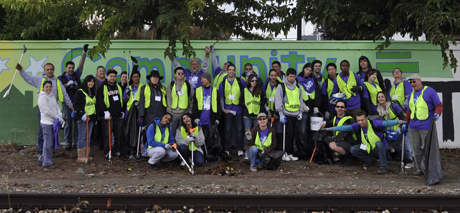It will “take a village” to preserve, maintain and expand urban parks in the 21st Century. A key feature of what I call the “new paradigm” of America’s Parks and Trails is that the future lies in forming coalitions—virtual villages—among a variety of interested parties. Re-imagining our parks systems means not counting on government to be the sole caretaker of these community treasures.
In San Jose there are already “virtual villages” forming around a variety of parks, trails and projects. These groupings usually include the primary custodial authority, the City of San Jose Department of Parks Recreation and Neighborhood Services (PRNS). PRNS has the responsibility for the 2,884 Acres of Parkland and 54-plus miles of trail. PRNS has withstood severe budget cuts and yet still manages to cover more than 200 neighborhood parks, nine regional parks, 94 sports fields, 80 tennis courts, 80,000 square feet of skate park, and much more.
To be able to have a first-class park system, San Jose needs to have active participation by citizens, as concerned individuals and as groups. This means a variety of participants from community activists (Helen Chapman, Jean Dresden, Terry Reilly, Beverly Rose Hopper, et al), and neighborhood associations (Martin-Fontana Parks Association, Hamman Park Neighborhood Association, Almaden Winery Park Neighborhood Association, VEP Community Association, etc.).
San Jose needs environmental interest groups (Save Our Trails), volunteer groups (Friends of Five Wounds Trail, Friends of the San Jose Rose Garden), innovative nonprofit organizations based in Parks (Veggielution at Emma Prusch Park) and educational organizations (Youth Science Institute at Alum Rock Park).
There is also a need for project-based groups (The Bronzino Field House project in Watson Park), service clubs (San Jose Downtown Rotary creating the Rotary Play Garden in Guadalupe River Park), corporate supporters (i.e., Pacific Gas and Electric, eBay, Wells Fargo, JDS Uniphase), and existing community support groups like Happy Hollow Foundation and the Guadalupe River Park Conservancy.
As expansive as this list is, San Jose needs more. Mollie Tobias, the volunteer coordinator for PRNS, recruits, trains and manages about 1,000 volunteers annually. The dollar value of the volunteer effort between 2009 and 2012 was more than $1 million. San Jose Parks Foundation acts as a catalyst and facilitator for as much of this activity as possible.
The foundation seeks to inform and inspire neighborhoods and other groups about what’s possible, and it acts as a Fiscal Agent to allow groups to function without having to incorporate as a nonprofit. All donations made through San Jose Parks Foundation are tax-deductible. Donors may choose to make a general contribution or to direct the funding to a specific fund or project.
Businesses, groups, organizations, clubs and citizens of San Jose all benefit from the parks and trails, and it takes all of these entities working together to maintain and grow these parks and trails in a future where municipalities will have less funding to do the job alone. Care to join?
James P. Reber is the executive director of San Jose Parks Foundation, a veteran nonprofit entrepreneur and experienced special event planner and producer. He can be reached at [email protected] or 408.893.PARK.




